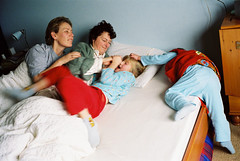 A recent New York Times article reported on some of the data that is known about gay and lesbian parenthood and how children of same-sex parents turn out.
A recent New York Times article reported on some of the data that is known about gay and lesbian parenthood and how children of same-sex parents turn out.
The Williams Institute at UCLA finds that approximately 115,772 American same-sex couples have children.
Summarizing the state of the field:
Until relatively recently, we didn’t know much about the children of same-sex couples. The earliest studies, dating to the 1970s, were based on small samples and could include only families who stepped forward to be counted. But about 20 years ago, the Census Bureau added a category for unwed partners, which included many gay partners, providing more demographic data. Not every gay couple that is married, or aspiring to marry, has children, but an increasing number do: approximately 1 in 5 male same-sex couples and 1 in 3 female same-sex couples are raising children, up from 1 in 20 male couples and 1 in 5 female couples in 1990.
Concerning child outcomes:
“These children do just fine,” says Abbie E. Goldberg, an assistant professor in the department of psychology at Clark University, who concedes there are some who will continue to believe that gay parents are a danger to their children, in spite of a growing web of psychological and sociological evidence to the contrary.
In most ways, the accumulated research shows, children of same-sex parents are not markedly different from those of heterosexual parents. They show no increased incidence of psychiatric disorders, are just as popular at school and have just as many friends. While girls raised by lesbian mothers seem slightly more likely to have more sexual partners, and boys slightly more likely to have fewer, than those raised by heterosexual mothers, neither sex is more likely to suffer from gender confusion nor to identify themselves as gay.
Gender plays a key role in the differences that are known between children of heterosexual and sexual minority parents:
More enlightening than the similarities, however, are the differences, the most striking of which is that these children tend to be less conventional and more flexible when it comes to gender roles and assumptions than those raised in more traditional families.
There are data that show, for instance, that daughters of lesbian mothers are more likely to aspire to professions that are traditionally considered male, like doctors or lawyers — 52 percent in one study said that was their goal, compared with 21 percent of daughters of heterosexual mothers, who are still more likely to say they want to be nurses or teachers when they grow up. (The same study found that 95 percent of boys from both types of families choose the more masculine jobs.) Girls raised by lesbians are also more likely to engage in “roughhousing” and to play with “male-gendered-type toys” than girls raised by straight mothers. And adult children of gay parents appear more likely than the average adult to work in the fields of social justice and to have more gay friends in their social mix.
Same-sex couples, it seems, are less likely to impose certain gender-based expectations on their children, says M. V. Lee Badgett, director of the Center for Public Policy and Administration at the University of Massachusetts at Amherst and author of “When Gay People Get Married: What Happens When Societies Legalize Same-Sex Marriage.” Studies of lesbian parents have found that they “are more feminist parents,” she says, “more open to girls playing with trucks and boys playing with dolls,” with fewer worries about conforming to perceived norms.
They are also, by definition, less likely to impose gender-based expectations on themselves. “Same-sex parents tend to be more equal in parenting,” Goldberg says, while noting that no generalization can apply to all parents of any sexual orientation. On the whole, though, lesbian mothers (there’s little data here on gay dads) tend not to divide chores and responsibilities according to gender-based roles, Goldberg says, “because you have taken gender out the equation. There’s much more fluidity than in many heterosexual relationships.”



